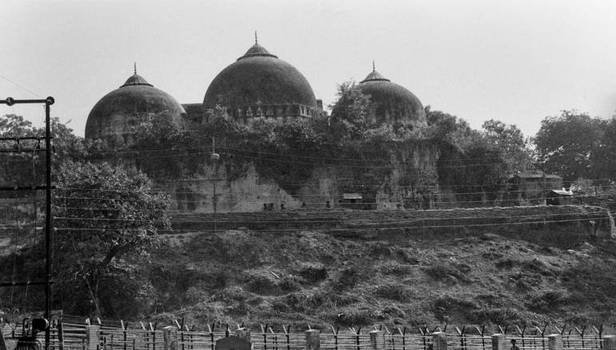'It is wrong to give entire land in Ayodhya to Hindu side'
15 Nov 2019 ( IBTN News Bureau )
Anupam Gupta, the lawyer of the Liberhan Commission, raised many questions on giving the entire land in Ayodhya to the Hindu side.
After the demolition of the Babri Masjid in India, senior advocate Anupam Gupta cross-examined Bharatiya Janata Party leaders LK Advani, Murali Manohar Joshi, Uma Bharti, Kalyan Singh associated with the Ram Temple movement. He was also cross-examined to the then Prime Minister of India, PV Narasimha Rao on this issue.
Justice MS Liberhan, who was investigating the case of Babri demolition 15 years ago, was Anupam Gupta, a lawyer for the commission and at that time he cross-examined BJP leaders at Vigyan Bhawan in New Delhi.
However, Anupam Gupta later differed with the Liberhan Commission and was criticized by Anupam Gupta in 2009 when the Commission submitted its final report.
In an interaction with the BBC, Anupam Gupta has strongly disagreed and criticized the Supreme Court's verdict on the Ayodhya dispute.
Anupam Gupta criticized the Supreme Court verdict on the Ayodhya case on the following points:
(1) The decision to give the entire disputed land to one party (Hindu side).
(2) Question regarding the proof of the prayers of Muslims within the mosque during 1528 to 1857.
(3) Violation of law by placing statues in the mosque in December 1949 and demolishing the entire structure in December 1992.
How much do you agree with the Supreme Court decision?
This decision brilliantly confirms this and I agree that a Hindu idol ie Ram Lala is a legal person. Therefore, the Law of Limitation does not arise in the case of a minor Ram Lala Virajaman (child form of Rama).
What do you disagree with about the decision?
I do not agree with the decision to give land within and outside the disputed land entirely to Hindus.
I disagree with the conclusion of ownership.
Even though the ownership of Hindus on the outer enclosure and the plea of Hindus to worship there without any interruption have long been accepted, the final decision on the inside yard is not compatible with other conclusions.
The court repeated this several times and held that the ownership of the area under the domes in the inner courtyard and the worship of the people were disputed.
Assuming this, the final relief should have been that the outer enclosure would have been given to the Hindus. But the question is, how can the inner enclosure also be given to Hindus?
The court's decision to arrive at the crucial decision that both the inner and outer enclosures should be given to Hindus is a fundamental contradiction with the court's conclusion that only the outer enclosure is the right of Hindus.
This decision also found that there is no evidence of the prayer being offered at the disputed site between 1528 and 1857. Your Opinion?
The court considers this to be the basis and I find it bizarre. The verdict states that no evidence has been provided from the Muslim side that namaz was read here between 1528 and 1857. Even though the case has been decided over the lack of evidence in the case, it is undisputed that a mosque was built in 1528 which was demolished in 1992.
If you believe that a church, gurudwara or temple was built somewhere during the Mughal rule, would you tell the community after hundreds of years - you have to prove that you worshiped there.
Even if Hindus believe that it is the birthplace of Lord Rama, this place is very revered. But Hindus also have no evidence that - Hindus continued to worship on the disputed land during 1528 to 1857.
But the court's decision did not prove that Muslims were offering prayers in 1857 in the mosque built in 1528. On what basis did the honorable court make this assumption?
Has the judgment of December 1949 and December 1992 been taken into account in this decision?
In the judgment, referring to the incident of placing statues of Ram Lala inside the main dome on 22 December 1949, it was described as 'desecrating the mosque', it was illegal.
But the result was that the entire land was confiscated. It has been rightly stated in the judgment that before 22 December 1949 there were no idols, yet this fact did not affect the court's conclusion, perception, analysis or evaluation.
The decision to demolish the mosque in December 1992 is considered a violation of law, but it does not affect the court emotionally, morally or intellectually.
With respect to the court, I do not consider it worthy of defense. These are basic theoretical facts that cannot be dismissed and this is sad.
In my opinion, giving the ownership of the entire structure to the Hindus is like rewarding the unjust party because they are guilty of keeping the idols in 1949 and breaking the structure in 1992.
What is the logic of the court on giving the outer and inner courtyards of the disputed site to the Hindus?
The court in its judgment has considered the entire structure as one. If it is a land that could not be divided and no one party was owning any of the land, then no party should be given a share of this land.
I want to say with all due respect to the Supreme Court that the kind of caution, fairness and balance that is required in such an important case is lacking in this decision which bothers me.
In my opinion, in its judgment, the Supreme Court held back from the principles and ideals of secularism.
(Click here for Android APP of IBTN. You can follow us on facebook and Twitter)
Share This News
About sharing
-
 16 Sep 2025
UN inquiry finds Israel’s war on Gaza to be genocide
16 Sep 2025
UN inquiry finds Israel’s war on Gaza to be genocide
UN inquiry finds Israel’s war on Gaza to be genocide
-
 16 May 2025
Has Donald Trump taken US-Gulf relations to a new era?
16 May 2025
Has Donald Trump taken US-Gulf relations to a new era?
Has Donald Trump taken US-Gulf relations to a new era?
May 16, 2...
-
 16 May 2025
What do the Gulf states gain from the US president's historic trip to the region?
16 May 2025
What do the Gulf states gain from the US president's historic trip to the region?
What do the Gulf states gain from the US president's historic trip to the regio...
-
 15 May 2025
Pakistan FM: US didn't force the ceasefire with India | Talk to Al Jazeera
15 May 2025
Pakistan FM: US didn't force the ceasefire with India | Talk to Al Jazeera
Pakistan FM: US didn't force the ceasefire with India | Talk to Al Jazeera
-
 15 May 2025
How will the lifting of US sanctions help Syrians rebuild their country?
15 May 2025
How will the lifting of US sanctions help Syrians rebuild their country?
How will the lifting of US sanctions help Syrians rebuild their country?



